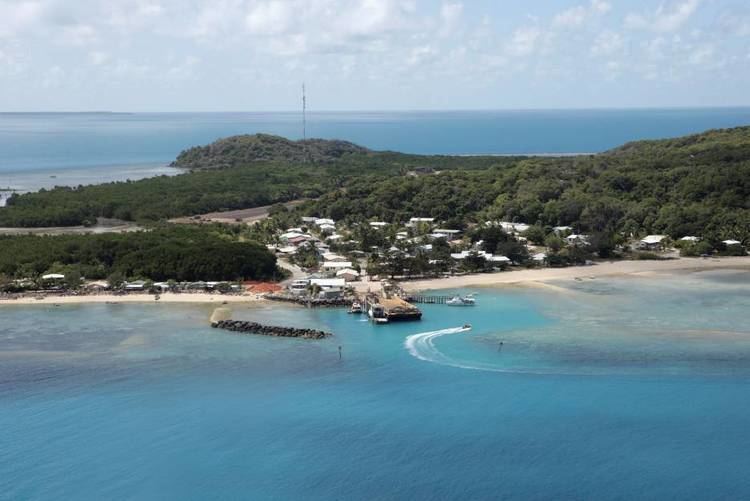Adjacent bodies of water Torres Strait Area 200 ha Adjacent body of water Torres Strait | State Queensland Population 338 (2001 census) Total islands 1 | |
 | ||
Location Tancred Passage, Northern Australia Archipelago Bourke Isles group, Torres Strait Islands Ethnic groups Torres Strait Islanders Local government area Torres Strait Island Region Island groups Torres Strait Islands, Bourke Isles | ||
Yam Island, called Yama or Iama in the Kulkalgau Ya language or Turtle-backed Island in English, is an island of the Bourke Isles group of the Torres Strait Islands, located in the Tancred Passage of the Torres Strait in Queensland, Australia. The island is situated approximately 100 kilometres (62 mi) northeast of Thursday Island and measures about 2 square kilometres (0.77 sq mi).
Contents
Map of Yam Island, Queensland 4875, Australia
Its indigenous language is Kulkalgau Ya, a dialect of the Western-Central Torres Strait language, Kalaw Lagaw Ya. The population of Yam was 338 as at the 2001 census.
Prehistory
Yam Island has interesting prehistory records in local legends in Papua and Torres Strait.
According to Mabuiag-Badu legend, Austronesian people from far-east Papua settled on Parema in the Fly Delta and married local trans-Fly women (of the group of peoples now called Gizra, Wipi, Bine, Meriam). Later they moved down to Torres Strait and settled on Yama, and then spread from there to different island groups. Westwards they went to Moa, Mabuiag, and there fought with local Aboriginal people and married some of the women, though apparently ‘purists’ who wanted to avoid further mixture moved north to Saibai, Boigu and Dauan. These initial settlements could have been anything up to around 2800 years ago. Eastwards they settled all the Central and Eastern Islands. They did not seem to have gone south to the Muralag group at this time. Much later, the Trans-Fly Meriam people of Papua moved to Mer, Erub and Ugar, taking most of the original inhabitants' land. These people, Western-Central Islanders, they called the Nog Le Common People, as opposed to the Meriam People, who are the noble people. Western-central Islanders in general are called the Gam Le Body People, as they are more thick-set on the whole than the slender Meriam.
This was the establishment of the Islanders as we know them today. Their languages are the mix of cultures mentioned above: the Western-Central language is an Australian (Paman) language with Austronesian and Papuan elements as cultural overlays, and the Eastern Language is dominantly Papuan, though with significant Australian and Austronesian elements.
According to Papuan legend [get reference : Lawrence 1998], a developing mud island near the mouth of a river to the south of the Fly Delta was first settled by people from Yama [in Kulkalgau Ya/Kalaw Lagaw Ya the name of the island is Dhaaru (Daru)], before the time that the Kiwai conquered the coastal parts of the South-West Fly Delta (perhaps at most around 700 years ago). The Yama had long-established trading and family contacts with the Trans-Fly Papuans, starting from the original Papuo-Austronesian settlements. When the Kiwai people started raiding and taking over territory, some of the Yama escaped to the Trans-Fly Papuans on the mainland, and others went across to Saibai, Boigu and Dauan to join their fellow Islanders there. However, the majority wanted to keep their tribal identity, and so decided to get as far away from the Kiwai as possible, and headed to the far south of Torres Strait, and settled on Moa, Muri and the Muralag group. A small core of Yama people stayed on Daru, and became virtually absorbed by the Daru Kiwai. The Kiwai call these people the Hiàmo (also Hiàma, Hiàmu - a Kiwai 'mispronunciation' of Yama, while the Yama people that moved to the Muralag group called themselves the Kauralaigalai (Kaurareg), in their modern dialect Kaiwaligal ‘Islanders’, in contrast to the Dhaudhalgal ‘Mainlanders of Papua’ and the Kawaigal or Ageyal ‘Aborigines of Australia’ (who are also Dhaudhalgal ‘Mainlanders’).
The Kaiwaligal (Kaurareg) and the Kulkalgal (Central Islanders) still have a close relationship, and traditionally considered themselves as closely related, much more than either is to the Mabuiag-Badu people or the Saibai-Dauan-Boigu people. The Kulkagal (Yama and others) have also kept their traditional ties with the Trans-Fly people, and also now with the Kiwai, who after their beginning as conquerors, have now become a part of the traditional trade network
History
Before colonisation the inhabitants traded and fought widely in their sailing canoes. First recorded sighting by Europeans of Yam Island was by the Spanish expedition of Luís Vaez de Torres on 8 September 1606. It was charted as Caribes island because of the tall warriors that were found there. In 1792, they came aboard William Bligh's two ships seeking iron. Bligh named Tudu 'Warrior Island' after an attack they later made. The London Missionary Society established a station at Yam's western end making it possible for a permanent village with people settling around the mission. Many of the men took jobs on pearling luggers and a pearling station operated on Tudu during the 1870s with another at Nagi (Mount Ernest Island, southwest of Yam). Pacific Islanders working at Nagi station later settled on Yam. During the World War II, many Yam men enlisted in the army, forming C Company of the Torres Strait Light Infantry Battalion.
Despite their seafaring background, Yam people were fairly isolated from the outside world until well after the War. An airstrip was constructed in 1974 and the island's connection to the Torres Strait telephone exchange occurred in 1980. Yam has provided the Torres Strait with important political leaders including Getano Lui Senior (grandson of the first LMS teacher, Lui Getano Lifu) and Getano Lui Junior, former chairman of the Island Coordinating Council.
